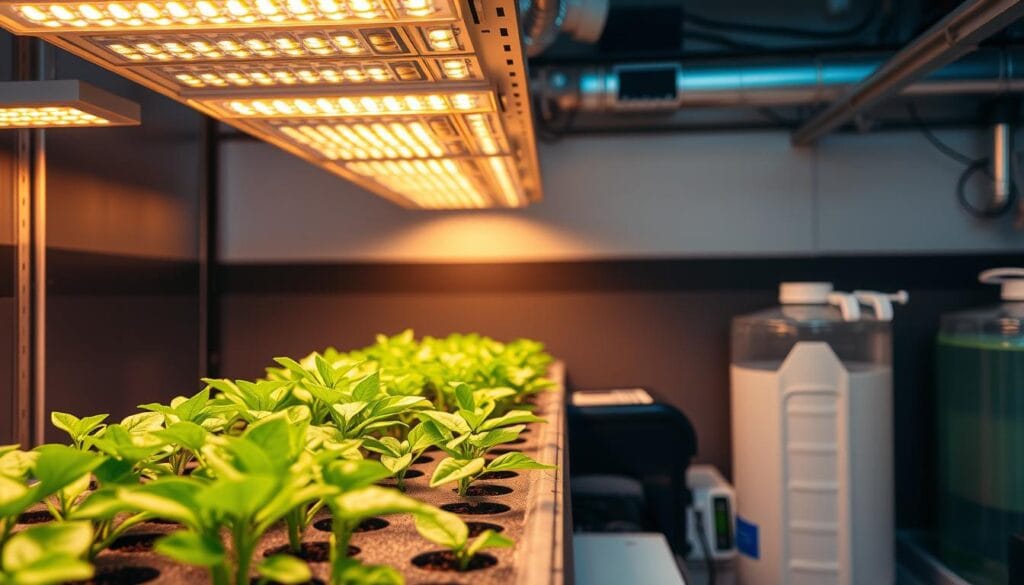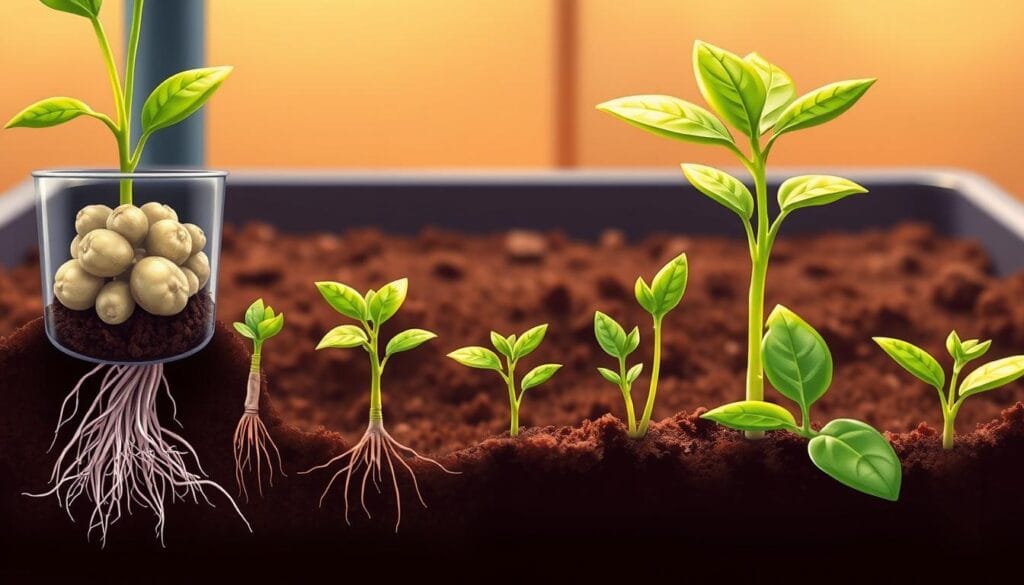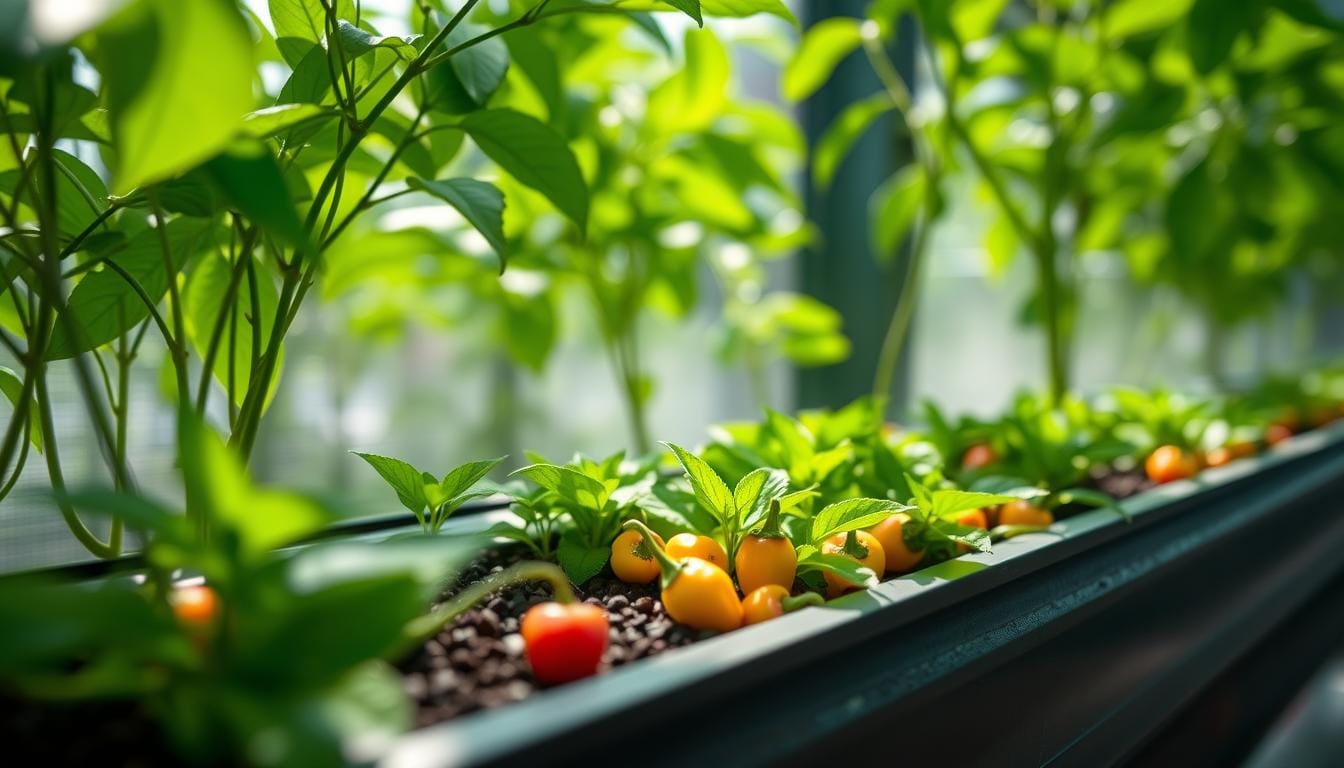Imagine turning your indoor space into a lively garden. Here, spicy, citrusy peppers grow without soil. Growing hot lemon pepper hydroponic plants is more than a gardening trick. It’s a path defined by precision, passion, and endless potential.
Hydroponic gardening lets chili pepper varieties grow in controlled spaces. Your indoor plant-growing adventure starts with knowing hot lemon pepper seeds. You’ll learn to care for them from tiny seedlings to strong plants.
This guide will show you how to create a thriving hydroponic pepper garden. You’ll learn secrets to grow these amazing plants with confidence.
Key Takeaways
- Master the unique requirements of hot lemon pepper hydroponic cultivation
- Learn precise techniques for seed starting and plant development
- Understand the critical environmental factors for successful growth
- Discover how hydroponic systems can optimize pepper plant health
- Gain insights into creating the ideal growing conditions for your plants
Understanding Seeds of Hot Lemon Pepper Hydroponic Plants
Hydroponic gardening opens up new ways to grow capsicum annuum, like the hot lemon pepper varieties. These plants are ideal for soil-free cultivation in greenhouses.
Hydroponic growing is a new way to grow plants. It lets gardeners control how plants grow. Let’s look at what makes these plants special.
Characteristics of Hot Lemon Pepper Varieties
Hot lemon pepper seeds are part of the capsicum annuum family. They have a unique taste. These plants are known for:
- Elongated fruits with a spicy-citrus taste
- Compact growth suitable for indoor cultivation
- Vibrant yellow-green coloration
- Moderate heat levels ranging from 5,000 to 30,000 Scoville units
Benefits of Hydroponic Growing
Soil-less cultivation has many benefits for greenhouse vegetables:
- 90% less water usage compared to traditional gardening
- Faster plant maturation
- Year-round indoor growing capabilities
- Significant reduction in pest-related issues
Plant Growth Requirements
| Growth Parameter | Optimal Range |
|---|---|
| Light Exposure | 16 hours daily |
| Nutrient Frequency | Every 1-2 weeks |
| Temperature | 70-85°F (21-29°C) |
| Germination Time | 2 weeks |
“Hydroponic gardening revolutionizes vegetable cultivation, offering unmatched precision and efficiency.” – Modern Agriculture Experts
Knowing about lemon pepper seeds and hydroponic growing helps you create the best environment for growing vegetables in greenhouses.
Essential Equipment and Materials for Seed Starting
Starting a hydroponic garden needs careful planning and the right tools. Choosing the best equipment for seed starting is key. It ensures your indoor plants grow well in a controlled environment.
- Growing Containers
- Cell trays with 6 or 4-cell configurations
- Biodegradable paper or peat pots
- Recycled nursery cell trays
- Hydroponic System Components
- Deep Water Culture system
- Nutrient Film Technique setup
- 3-gallon storage bins
- Essential Measurement Tools
- Digital pH meter
- EC meter for nutrient strength
- Thermometer
- Hygrometer for humidity tracking
“The proper tools elevate seed starting from a task to an art.” – Hydroponic Gardening Experts
Choose a good growing medium like rock wool cubes or coco coir. They support seedlings well. For light, LED grow lights are a great choice. They save energy and mimic natural sunlight, giving your plants 10+ hours of light.
Don’t forget quality seeds and a balanced 3-part liquid hydroponic fertilizer. With the right gear, you’re ready for a successful indoor gardening journey.
Preparing Your Hydroponic System for Seeds
Starting your hydroponic journey requires careful setup. You need to prepare your greenhouse for growing vegetables without soil. This method, known as controlled environment agriculture, needs attention to detail.
Before you start with seeds, make sure your growing space is perfect. The right setup is essential for cultivating healthy, thriving plants.
Setting Up Growing Containers
Choose containers that drain well and let air in. They should:
- Support root growth
- Let nutrients move around
- Stop water from staying too long
- Meet the needs of hot lemon pepper plants
Creating the Perfect Environment
Getting the environment right is vital for seed success. Keep these conditions in mind:
| Parameter | Ideal Range |
|---|---|
| Temperature | 70-80°F (21-27°C) |
| Humidity | 60-70% |
| Light Exposure | 16 hours daily |
Nutrient Solution Preparation
Creating the right nutrient mix is essential for seedlings. Focus on these points:
- Keep EC (electrical conductivity) at 0.5-0.8 mS/cm
- Adjust pH to 5.5-6.5
- Use a weak nutrient mix for seedlings
“The foundation of successful hydroponic growing lies in precise environmental control and nutrient management.” – Hydroponic Expert.
Every step in setting up your hydroponic system is important. Take your time and be detailed. This will help your hot lemon pepper seeds grow well.
Proper Lighting Requirements for Seedlings

Lighting is key for growing plants indoors. For hot lemon pepper plants, the right light is essential for seedling growth.
Seedlings need specific light to grow well. Here are the main lighting points:
- Daily light exposure: 14-16 hours
- Light intensity: 200-400 μmol/m²/s
- Recommended light spectrum: Full-spectrum LED grow lights
- Initial light positioning: 4-6 inches above seedlings
Pro tip: Keep the light distance the same to avoid plant stretching or light burn.
“The right light can transform your seedlings from fragile starts to robust plants.” – Hydroponic Growing Expert.
LED grow lights are great for indoor plants. They use less energy, don’t get hot, and give the best light for seedlings. Choose full-spectrum LEDs that match natural sunlight.
Ensure your plants receive 8-10 hours of uninterrupted darkness daily. This dark time helps with growth and health in indoor growing.
- Light temperature: 5,000-7,000 Kelvins
- Recommended light type: Energy-efficient LEDs
- Positioning: Adjustable height to accommodate plant growth
Watch your seedlings and change the light as needed. Good light care is vital for strong, healthy hot lemon pepper plants.
Temperature and Humidity Control
Mastering temperature and humidity is key in controlled environment agriculture. It’s vital for growing healthy hot lemon pepper seedlings. The right environment can greatly affect your plant’s growth and productivity.
Optimal Temperature Ranges for Seedling Development
Creating the right temperature is essential for your hot lemon pepper plants. You should aim for specific temperature ranges that support strong growth:
- Daytime temperatures: 75-85°F (24-29°C)
- Nighttime temperatures: 65-75°F (18-24°C)
- Germination zone: Consistent warmth around 80°F (27°C)
Humidity Management Techniques
Controlling humidity is key in growing greenhouse vegetables. Here are some strategies to follow:
- Maintain 60-70% humidity during seed germination
- Gradually reduce humidity to 50-60% as seedlings mature
- Use humidity domes for initial moisture retention
Environmental Monitoring Tools
Invest in reliable monitoring equipment for your setup:
| Tool | Purpose | Recommended Accuracy |
|---|---|---|
| Digital Thermometer | Track temperature variations | ±0.5°F precision |
| Hygrometer | Measure relative humidity | ±3% humidity range |
| Automated Climate Control System | Regulate environmental conditions | Real-time monitoring |
“Precision in environmental control transforms good gardening into exceptional plant cultivation.”
By using these strategies, you’ll create a perfect growing environment. This environment will support healthy hot lemon pepper seedlings from germination to early development.
Germination Process and Timeline

Growing hot lemon pepper hydroponic plants needs patience and the right conditions. Your lemon pepper seeds usually germinate in 10-16 days. This time can vary based on the seed type and the environment.
For your seeds to germinate well, focus on a few key things. These elements are vital for growing your hydroponic peppers successfully.
“Seed germination is the enchanting moment when a seed springs to life.” – Hydroponic Gardening Expert.
To increase your chances of success with lemon pepper seeds, follow these important steps:
- Soak seeds in warm water for 24 hours to boost germination before planting.
- Use a consistent soil temperature between 70-90°F
- Plant seeds about 1/4 inch deep
- Keep the soil moist but not too wet
- Make sure there’s good airflow to avoid disease
Your hydroponic setup is very important for seed germination. Keep the humidity at 70-80% at first. Once the seedlings come up, lower the humidity. This helps prevent disease and helps the plants grow strong.
Keeping a garden journal can be very helpful. Write down things like how many seeds germinate, when they come up, and any problems you face. This will help you improve your growing skills for future hot lemon pepper plants.
Seed quality is also very important. Try to get a germination rate of 60-80% when starting your hydroponic pepper seeds. Seeds with less than 2.7% free space usually have a higher chance of growing well.
Transplanting and Early Care Techniques
Successful hydroponic gardening needs careful attention during transplanting. Your hot lemon pepper seedlings will be ready for their new home after 2-3 sets of true leaves. This usually happens 3-4 weeks after they germinate.
When to Transplant Seedlings
Timing is key in soil-less cultivation. Look for these signs that your seedlings are ready to transplant:
- 2-3 sets of true leaves have developed
- Seedlings are 3-4 weeks old
- Root system appears strong and healthy
- Plants show consistent growth
Handling Delicate Plants
When moving your seedlings, be very careful. Always handle them by the leaves or root ball to avoid damaging the stems. Gentle handling helps your plants make it through the transition in your hydroponic system.
Initial Nutrient Requirements
| Nutrient Aspect | Recommended Range |
|---|---|
| Electrical Conductivity (EC) | 1.0-1.5 mS/cm |
| pH Levels | 5.5-6.5 |
Slowly increase nutrient concentration to support your young plants. Monitor pH levels closely and make adjustments as necessary for optimal growth. Your careful attention during this stage will help your hydroponic harvest succeed.
“Patience and precision are the keys to transplanting success in hydroponic gardening.” – Experienced Hydroponic Grower.
Remember, each plant is different. Watch your hot lemon pepper seedlings closely and adjust your care as needed. With the right transplanting and early care, you’ll be on your way to a great hydroponic harvest.
Common Challenges and Solutions
Growing hot lemon pepper seedlings hydroponically has its own set of challenges. It’s important to know these issues to grow capsicum annuum successfully in a controlled setting.
Key Challenges in Hydroponic Pepper Cultivation
- Damping-off disease: A critical threat to young seedlings
- Nutrient deficiencies impacting plant health
- Pest infestations disrupting growth
- Environmental stress factors
To keep chili pepper varieties healthy, prevention is key. Good air circulation and careful watering can help prevent damping off.
Pest Management Strategies
| Pest Type | Prevention Method | Treatment |
|---|---|---|
| Aphids | Regular inspection | Neem oil spray |
| Spider Mites | Maintain humidity | Insecticidal soap |
| Whiteflies | Yellow sticky traps | Biological controls |
“Achieving success in hydroponic pepper farming necessitates diligent observation and forward-thinking management.” – Hydroponic Growing Expert
It’s vital to keep an eye on nutrient levels for capsicum annual growth. Keep EC levels between 1.2 and 2.0. Adjust nutrients as plants grow. Regular pH checks between 5.5 and 7.0 help with nutrient absorption.
Nutrient Management Tips
- Check EC levels weekly
- Adjust nutrient solutions promptly
- Maintain proper pH balance
- Use potassium-rich fertilizers
By following these tips, you can tackle common hydroponic challenges. This way, you can grow strong, healthy hot lemon pepper plants.
Monitoring Growth and Plant Development
In hydroponic gardening, it’s key to watch your hot lemon pepper plant grow. This method lets you see each growth stage closely. It’s all about precision and care.
When you monitor your plant, look at a few important things:
- Stem strength and color
- Leaf vibrancy and expansion
- Root system development
- Overall plant structure
Take measurements every week to check your plant’s health. Tracking regularly helps you adjust nutrients and the environment. Keep an eye on these signs of growth:
- Measure plant height every 7 days
- Check leaf width and count
- Observe stem diameter thickness
- Watch for flower bud formation
“In hydroponic systems, precise monitoring transforms gardening from guesswork to scientific cultivation.” – Agricultural Research Institute.
Knowing the root zone temperature is key. Studies show it affects plant growth and productivity in controlled environments.
As your hot lemon pepper plants grow, you’ll need to tweak lighting, nutrients, and environment. Pruning can help them grow bushier and increase your harvest.
Conclusion
Growing hot lemon pepper hydroponic plants needs dedication and precision. Your journey in indoor plant growing requires careful attention at every stage. With the right techniques, you can turn your home into a productive pepper garden.
The secret to successful hydroponic gardening is knowing what hot pepper varieties need. Investing in quality seeds, proper equipment, and consistent monitoring will give you strong plants with great flavor. Every step, from seed selection to harvest, is important for a thriving pepper garden.
Hydroponic gardening is both a science and an art. Each pepper plant is a chance to improve your skills and learn more. By following the strategies in this guide, you’ll be ready to grow delicious hot lemon peppers indoors.
Be open to learning, stay patient, and enjoy the rewarding journey of growing your hydroponic hot pepper garden. From tiny seeds to mature plants, it’s a fulfilling experience.

